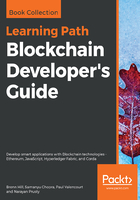
What this book covers
Chapter 1, Blockchain 101, explains what blockchain technologies are and how they work. We also introduce the concept of the distributed ledger.
Chapter 2, Components and Structure of Blockchain, takes a closer look at the technical underpinnings of a blockchain and peeks under the hood to understand what a block is and how the chain is created.
Chapter 3, Decentralization Versus Distributed Systems, covers different types of decentralized and distributed systems and cover the often-overlooked differences between them.
Chapter 4, Cryptography and Mechanics Behind Blockchain, discusses the fundamentals of cryptographic systems which are critical to the proper functioning of all blockchains.
Chapter 5, Bitcoin, examine Bitcoin, the first blockchain, and it's specific mechanics in depth.
Chapter 6, Altcoins, covers the major non-bitcoin cryptocurrency projects that have gained popularity over the last few years.
Chapter 7, Achieving Consensus, looks into the different ways blockchains help achieve consensus. This is one of the most important aspects of blockchain behavior.
Chapter 8, Advanced Blockchain Concepts, covers the interactions between blockchain technology, privacy, and anonymity along with some of the legal side effects of blockchain technology.
Chapter 9, Cryptocurrency Wallets, covers the different wallet solutions that exist for keeping your cryptocurrency secure.
Chapter 10, Alternate Blockchains, examine blockchain creation technologies such as Tendermint and Graphene, and other non-currency based blockchain technologies.
Chapter 11, Hyperledger and Enterprise Blockchains, examine the Hyperledger family of distributed ledger technologies aimed at corporate and enterprise use.
Chapter 12, Ethereum 101, look at Ethereum, the second most dominant blockchain technology today.
Chapter 13, Solidity 101, cover the basics of Solidity, the Ethereum programming language.
Chapter 14, Smart Contracts, covers the smart contracts, which are enabled in different ways by different blockchain technologies.
Chapter 15, Ethereum Accounts and Ether Tokens, in this chapter, we look at the mechanics of Ethereum accounts and the token itself in the Ethereum system.
Chapter 16, Decentralized Applications, discusses decentralized applications as a whole, including ones that operate without a blockchain or in tandem with blockchain technologies.
Chapter 17, Mining, we cover blockchain mining and how this is used to secure blockchains, the different types of hardware used in mining, and the different protocols involved.
Chapter 18, ICO 101, we cover the basics of launching an Initial Coin Offering or Initial Token Offering.
Chapter 19, Creating Your Own Currency, we cover the creation of your own blockchain based cryptocurrency.
Chapter 20, Scalability and Other Challenges, covers the difficulties and limitations currently facing blockchain technology.
Chapter 21, Future of Blockchain, we examine the possible future developments of the industry technologically, legally, and socially.
Chapter 22, Understanding Decentralized Applications, will explain what DApps are and provide an overview of how they work.
Chapter 23, Understanding How Ethereum Works, explains how Ethereum works.
Chapter 24, Writing Smart Contracts, shows how to write smart contracts and use geth's interactive console to deploy and broadcast transactions using web3.js.
Chapter 25, Getting Started with web3.js, introduces web3js and how to import, connect to geth, and explains use it in Node.js or client-side JavaScript.
Chapter 26, Building a Wallet Service, explains how to build a wallet service that users can create and manage Ethereum Wallets easily, even offline. We will specifically use the LightWallet library to achieve this.
Chapter 27, Building a Smart Contract Deployment Platform, shows how to compile smart contracts using web3.js and deploy it using web3.js and EthereumJS.
Chapter 28, Building a Betting App, explains how to use Oraclize to make HTTP requests from Ethereum smart contracts to access data from World Wide Web. We will also learn how to access files stored in IPFS, use the strings library to work with strings, and more.
Chapter 29, Building Enterprise Level Smart Contracts, explains how to use Truffle, which makes it easy to build enterprise-level DApps. We will learn about Truffle by building an alt-coin.
Chapter 30, Building a Consortium Blockchain, we will discuss consortium blockchain.